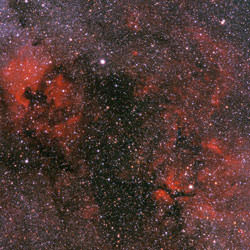
NGC7000/Gamma Cygni. Image credit: Gary Hatfield. Click to enlarge.

Space and astronomy news

NGC7000/Gamma Cygni. Image credit: Gary Hatfield. Click to enlarge.
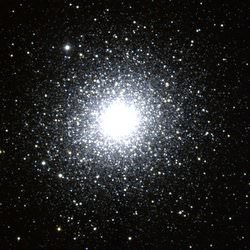
M2. Image credit: Doug Williams/REU Program NOAO/AURA/NSF.
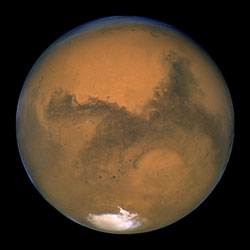
Mars. Image credit: NASA/JPL
Monday, October 17 – Did readers on the West Coast get a chance to see the partial lunar eclipse this morning? Excellent, because the Full Hunter’s Moon will make “hunting” most deep sky objects next to impossible tonight. But who cares when you can see Mars in such great detail!
Is it really that good and really that worth the wait for it to rise? The answer is yes. Even through a small telescope it is very easy to see the dark markings and the brilliant polar cap. Although Mars won’t rise for good viewing until late evening, don’t wait any longer to start your observations. In larger telescopes at higher powers, you will see Mars as you have never seen it before. Even if you do not use a telescope, you cannot miss this huge, bright, reddish planetary disc rising in the east.
Want a map? Care to sketch? Or would you just like more details? Then you’ll find no site more comprehensive than the Association of Lunar and Planetary Observers. This ALPO page contains everything you’ll need to tun this year’s “Mars Experience” into the best you’ve ever had!
Tuesday, October 18 – Today in 1959, Soviet Luna 3 began returning the first photographs of the Moon’s far side. Also today – but in 1967 – the Soviets again made history as Venera 4 became the first spacecraft to probe Venus’ atmosphere. Unlike Mars, Venus shows little details but it’s still a fine way to start the evening. Look for its bright, phasic disc just west of Sagittarius after sunset.
If you’d really like to see some details, try looking at the lunar surface tonight and focus your attention towards the stretched oval of crater Gauss located about midway on the northern quadrant of the eastern limb. With the terminator so near, can you see four southern interior craters? Move further south and central on the limb. Mare Smythii might be gone, but look at small, overlapping craters Jenkins and Nobili.
Wednesday, October 19 – For viewers in Spain, Portugal, Italy and Greece, you have a very rare and exciting event this morning! Asteroid Rhodope will eclipse bright star – Regulus. While this event requires no special equipment, your observances could make a significant contribution to the folks at the International Occultation and Timing Association (IOTA). Please take the time to visit this page for details on how you can help scientific studies. An event like this won’t happen again until 2014… Please watch. Wishing you clear skies!
For viewers in the United States and Canada, tonight is a definitely celestial gathering as the Moon, Mars and the Pleiades will make a wonderfully tight trio as the come up in the east, and this would be a great night to explore!
While we’re waiting on them to rise, let’s have a look in Cassiopeia at two of its primary stars.
Looking much like a flattened “W” the southern-most bright star is Alpha. Also known as Schedar, this magnitude 2.2 spectral type K star, was once suspected of being a variable, but no changes have been detected in modern astronomy. Binoculars will reveal its orange/yellow coloring, but a telescope is needed to bring out its unique features. In 1781, Sir William Herschel discovered a 9th magnitude companion star and our modern optics easily separate the blue/white component’s distance of 63″. A second, even fainter companion at 38″ is mentioned in the list of double stars and even a third at 14th magnitude was spotted by S.W. Burnham in 1889. All three stars are optical companions only, but make 150 to 200 light year distant Schedar a delight to view.
Just north of Alpha is the next destination for tonight – Eta Cassiopeiae. Discovered by Sir William Herschel in August of 1779, Eta is quite possibly one of the most well-known of binary stars. The 3.5 magnitude primary star is a spectral type G, meaning it has a yellowish color much like our own Sun. It is about 10% larger than Sol and about 25% brighter. The 7.5 magnitude secondary (or B star) is very definitely a K-type, metal poor, and distinctively red. In comparison, it is half the mass of our Sun, crammed into about a quarter of its volume and around 25 times dimmer. In the eyepiece, the B star will angle off to the northwest, providing a wonderful and colorful look at one of the season’s finest.
Thursday, October 20 – Tonight is one of the busiest night skies of the year. We are now slipping into the stream of Comet Halley and into one of the finest meteor showers around, but the Moon is going to play a very major role through tonight and tomorrow morning.
For viewers in the southern part of Europe and the northern portion of Africa, you will have the chance to watch the Moon occult 27 Taurii tonight. Be sure to visit this IOTA webpage for charts and times in your location.
If you should happen to live a little more centrally in Africa, or in South America, it just gets better as the Moon will coast through the Pleiades star cluster on this date for you. Thanks to the good folks at IOTA, you can use this reference material for more specific details. Clear skies!
Friday, October 21 – Be sure to be outdoors before dawn to enjoy one of the year’s most reliable meteor showers. The offspring of Comet Halley will grace the early morning hours as they return once again as the Orionid meteor shower. This dependable shower produces an average of 10-20 meteors per hour at maximum and the best activity begins before local midnight on the 20th, and reaches its best as Orion stands high to the south at about two hours before local dawn on the 21st.
Although Comet Halley has long since departed our Solar System, the debris left from its trail still remain scattered in Earth’s orbital pattern around the Sun allowing us to predict when this meteor shower will occur. We first enter the “stream” at the beginning of October and do not leave it until the beginning of November, making your chances of “catching a falling star” even greater. These meteors are very fast, and although they are faint, it is still possible to see an occasional “fireball” that leaves a persistent trail.
Clouded out or the Moon too bright? Don’t worry. You don’t always need your eyes or perfect skies to meteor watch. By tuning an FM radio to the lowest frequency possible that does not receive a “clear signal”, you can practice radio meteor listening. An outdoor FM antenna pointed at the zenith and connected to your receiver will increase your chances, but it’s not necessary. Simply turn up the static and listen. Those hums, whistles, beeps, bongs, and occasional snatches of signals are our own radio signals being reflected off the meteor’s ion trail!
For viewers over most of Australia, be sure to keep an eye on the sky tonight as the Moon will occult bright Beta Taurii for most locales on this universal date. Be sure to check IOTA for more specific details.
Saturday, October 22 – Something very special happened today in 2136 B.C. There was a solar eclipse and for the very first time it was seen and recorded by Chinese astronomers. And probably a very good thing because royal astronomers were executed for failure to predict!
Today is also the birthday of Karl Jansky. Born in 1905, Jansky was an American physicist as well as an electrical engineer. One of his pioneer discoveries were non-Earth based radio waves at 20.5 MHz while investigating noise sources between 1931 and 1932. And, in 1975, Soviet Venera 9 was busy sending Earth the very first look and Venus’ surface.
Thanks to just a slightly later rise of the Moon, let’s return again to Cassiopeia and start first by exploring the central most bright star, Gamma. At approximately 100 light years away, Gamma is a very unusual star. Once thought to be a variable, this particular star has been known to go through some very radical changes with its temperature, spectrum, magnitude, color and even diameter. Gamma is also a visual double star, but the 11 magnitude companion is highly difficult to perceive so close (2.3″) from the primary.
Four degrees southeast of Gamma is our marker for this starhop, Phi Cassiopeiae. By aiming binoculars or telescopes at this star, it is very easy to locate an interesting open cluster, NGC 457, because they will be in the same field of view. This bright and splendid galactic cluster has received a variety of names over the years because of its uncanny resemblance to a figure. Some call it an “Angel”, others see it as the “Zuni Thunderbird”, I’ve heard it called the “Owl” and the “Dragonfly”, but perhaps my most favourite is the “E.T. Cluster”, As you view it, you can see why. Bright Phi and HD 7902 appear like “eyes” in the dark and the dozens of stars that make up the “body” appear like outstretched “arms” or “wings”. (For E.T. fans? Check out the red “heart” in the center.)
All this is very fanciful, but what is the NGC 457, really? Both Phi and HD 7902 may not be true members of the cluster. If magnitude 5 Phi were actually part of this grouping, it would have to have a distance of approximately 9300 light years, making it the most luminous star in the sky, far outshining even Rigel! To get a rough of idea of what that means, if we were to view our own Sun from this far away, it would be no more than magnitude 17.5. The fainter members of the NGC457 comprise a relatively “young” star cluster that spans about 30 light years across. Most of the stars are only about 10 million years old, yet there is 8.6 magnitude red supergiant in the center.
Sunday, October 23 – With tonight’s early dark skies, let’s take out binoculars and have a look at an old favourite – “The Double Cluster” – NGC869 and NGC884. This pair of rich galactic open clusters rising in the northeast are an unaided-eye object from a dark site, easily seen in the smallest of binoculars from urban locations and beyond compare when viewed with a telescope at lowest power.
The western-most of the pair is NGC869, also known as “h Perseii”. It contains at least 750 stars clustered in a brilliant mass spanning about 70 light years, and approximately 7,500 light years away from us. It’s eastern companion is NGC884, or “Chi Perseii”. The statistics are almost a match, but NGC884 only has about half as many stars – some being “super giants” over 50,000 times brighter than our own Sun. These twin clusters have only one major difference: NGC884 is approximately 10 million years old and the NGC869 is perhaps 5 million. The existance of these splendid clusters was cataloged as far back as 350 B.C. with both Ptolemy and Hipparchus noting their appearance – yet Messier never “discovered” them!
This issue celebrates a full year of appearing on “The Universe Today”. I thank all of you who have taken the time to write and I would love to hear your suggestions for next year. Thank you for reading! Until next week? Ask for the Moon, but keep reaching for the stars! May all your journeys be at light speed…. ~Tammy Plotner
Chinese astronauts Fei Junlong and Nie Haisheng landed safely in Mongolia on Sunday, after spending 5 days in orbit. Their Shenzhou-6 capsule touched down by parachute less than a kilometre from their target, and were met by helicopters and off-road vehicles. Fei and Nie will spend the next 14 days in isolation, to observe their post flight health; however, their families will be able to visit. The Chinese Space Administration has hinted that spacewalks and women astronauts will be in future missions.
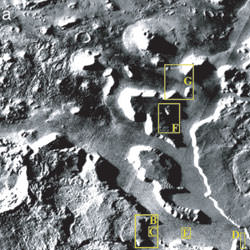
Viking image of Mars. Image credit: NASA/JPL. Click to enlarge.
New high-resolution images of mid-latitude Mars are revealing glacier-formed landscapes far from the Martian poles, says a leading Mars researcher.
Conspicuous trains of debris in valleys, arcs of debris on steep slopes and other features far from the polar ice caps bear striking similarities to glacial landscapes of Earth, says Brown University’s James Head III. When combined with the latest climate models and orbital calculation for Mars, the geological features make a compelling case for Mars having ongoing climate shifts that allow ice to leave the poles and accumulate at lower latitudes.
“The exciting thing is a real convergence of these things,” said Head, who will present the latest Mars climate discoveries on Sunday, 16 October, at the Annual Meeting of the Geological Society of America in Salt Lake City (specific time and location provided below).
“For decades people have been saying that deposits at mid and equatorial latitudes look like they are ice-created,” said Head. But without better images, elevation data and some way of explaining it, ice outside of Mars’ polar regions was a hard sell.
Now high-resolution images from the Mars Odyssey spacecraft’s Thermal Emission Imaging System combined with images from the Mars Global Surveyor spacecraft’s Mars Orbiter Camera and Mars Orbiter Laser Altimeter can be compared directly with glacier features in mountain and polar regions of Earth. The likenesses are hard to ignore.
For instance, consider what Head calls “lineated valley fill.” These are lines of debris on valley floors that run downhill and parallel to the valley walls, as if they mark some sort of past flow. The same sorts of lines of debris are seen in aerial images of Earth glaciers. The difference is that on Mars the water ice sublimes away (goes directly from solid ice to gas, without any liquid phase between) and leaves the debris lines intact. On Earth the lines of debris are usually washed away as a glacier melts.
The lines of debris on Mars continue down valleys and converges with other lines of debris – again, just like what’s seen on Earth where glaciers converge.
“There’s so much topography and the debris is so thick (on Mars) that it’s possible some of the ice might still be there,” said Head. The evidence for present day ice includes unusually degraded recent impact craters in these areas – just what you’d expect to see if a lot of the material ejected from the impact was ice that quickly sublimed away.
Another peculiarly glacier-like feature seen in Martian mid-latitudes are concentric arcs of debris breaking away from steep mountain alcoves – just as they do at the heads of glaciers on Earth.
As for how ice could reach Mars lower latitudes, orbital calculations indicate that Mars may slowly wobble on its spin axis far more than Earth does (the Moon minimizes Earth’s wobble). This means that as Mars’ axis tilted to the extremes – up to 60 degrees from the plane of Mars’ orbit – the Martian poles get a whole lot more sunshine in the summertime than they do now. That extra sun would likely sublime water from the polar ice caps, explains Head.
“When you do that you are mobilizing a lot of ice and redistributing it to the equator,” Head said. “The climate models are saying it’s possible.”
It’s pure chance that we happen to be exploring Mars when its axis is at a lesser, more Earth-like tilt. This has led to the false impression of Mars being a place that’s geologically and climatically dead. In fact, says Head, Mars is turning out to be a place that is constantly changing.
Original Source: Geological Society of America News Release
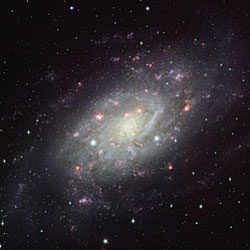
Spiral Galaxy NGC 2403. Image credit: Subaru. Click to enlarge.
Subaru Telescope, using Suprime-Cam, took the clearest most complete image to date of the spiral galaxy NGC 2403. At a distance of 10 million light years, NGC 2403 is an Sc type galaxy, which has open spiral arms and a small nucleus. It is approximately half the mass of our own galaxy, the Milky Way, and has an abundance of neutral hydrogen gas. In the spiral arms we see active star formation regions in red, clusters of young blue stars called OB associations, and darker regions called dust lanes where light is blocked by gas and dust within the galaxy.
This is not the first time NGC 2403 has been studied. Edwin Hubble used NGC 2403 as evidence that more distant galaxies move more quickly away from us, now called Hubble’s Law. It was also used to develop the Tully-Fisher relation, which states that there is a relation between a galaxy’s rotational speed and its brightness. NGC 2403 has become an important standard galaxy when deciding the distances to other galaxies, as we recognize the vast expanse of space.
Larger galaxies are thought to have developed from the collision and merger of smaller galaxies. Mergers can leave enduring marks on a galaxy’s halo, the most extended and generally spherical component of a galaxy. There is evidence that relatively young stars exist in the halo of NGC 2403, hinting at a recent merger with another galaxy. Astronomers are now studying this image to see if the color and brightness of the stars in the halo of NGC 2403 will reveal conclusive evidence of past mergers.
Original Source: Subaru News Release

An artist’s rendering of the Integrated Powerhead Demonstrator. Image credit: NASA. Click to enlarge.
When you think of future rocket technology, you probably think of ion propulsion, antimatter engines and other exotic concepts.
Not so fast! The final chapter in traditional liquid-fueled rockets has yet to be written. Research is underway into a new generation of liquid-fueled rocket designs that could double performance over today’s designs while also improving reliability.
Liquid-fueled rockets have been around for a long time: The first liquid-powered launch was performed in 1926 by Robert H. Goddard. That simple rocket produced roughly 20 pounds of thrust, enough to carry it about 40 feet into the air. Since then, designs have become sophisticated and powerful. The space shuttle’s three liquid-fueled onboard engines, for instance, can exert more than 1.5 million pounds of combined thrust en route to Earth orbit.
You might assume that, by now, every conceivable refinement in liquid-fueled rocket designs must have been made. You’d be wrong. It turns out there’s room for improvement.
Led by the US Air Force, a group consisting of NASA, the Department of Defense, and several industry partners are working on better engine designs. Their program is called Integrated High Payoff Rocket Propulsion Technologies, and they are looking at many possible improvements. One of the most promising so far is a new scheme for fuel flow:
The basic idea behind a liquid-fueled rocket is rather simple. A fuel and an oxidizer, both in liquid form, are fed into a combustion chamber and ignited. For example, the shuttle uses liquid hydrogen as its fuel and liquid oxygen as the oxidizer. The hot gases produced by the combustion escape rapidly through the cone-shaped nozzle, thus producing thrust.
The details, of course, are much more complicated. For one, both the liquid fuel and the oxidizer must be fed into the chamber very rapidly and under great pressure. The shuttle’s main engines would drain a swimming pool full of fuel in only 25 seconds!
This gushing torrent of fuel is driven by a turbopump. To power the turbopump, a small amount of fuel is “preburned”, thus generating hot gases that drive the turbopump, which in turn pumps the rest of the fuel into the main combustion chamber. A similar process is used to pump the oxidizer.
Today’s liquid-fueled rockets send only a small amount of fuel and oxidizer through the preburners. The bulk flows directly to the main combustion chamber, skipping the preburners entirely.
One of many innovations being tested by the Air Force and NASA is to send all of the fuel and oxidizer through their respective preburners. Only a small amount is consumed there–just enough to run the turbos; the rest flows through to the combustion chamber.
This “full-flow staged cycle” design has an important advantage: with more mass passing through the turbine that drives the turbopump, the turbopump is driven harder, thus reaching higher pressures. Higher pressures equal greater performance from the rocket.
Such a design has never been used in a liquid-fueled rocket in the U.S. before, according to Gary Genge at NASA’s Marshall Space Flight Center. Genge is the Deputy Project Manager for the Integrated Powerhead Demonstrator (IPD)–a test-engine for these concepts.
“These designs we’re exploring could boost performance in many ways,” says Genge. “We’re hoping for better fuel efficiency, higher thrust-to-weight ratio, improved reliability–all at a lower cost.”
“At this phase of the project, however, we’re just trying to get this alternate flow pattern working correctly,” he notes.
Already they’ve achieved one key goal: a cooler-running engine. “Turbopumps using traditional flow patterns can heat up to 1800 C,” says Genge. That’s a lot of thermal stress on the engine. The “full flow” turbopump is cooler, because with more mass running through it, lower temperatures can be used and still achieve good performance. “We’ve lowered the temperature by several hundred degrees,” he says.
IPD is meant only as a testbed for new ideas, notes Genge. The demonstrator itself will never fly to space. But if the project is successful, some of IPD’s improvements could find their way into the launch vehicles of the future.
Almost a hundred years and thousands of launches after Goddard, the best liquid-fueled rockets may be yet to come.
Original Source: NASA Science Article
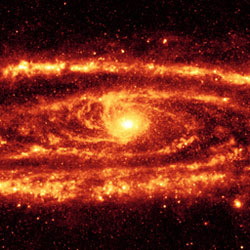
Giant mosaic of Andromeda made up of 11,000 images. Image credit: NASA/JPL. Click to enlarge.
NASA’s Spitzer Space Telescope has captured a stunning infrared view of Messier 31, the famous spiral galaxy also known as Andromeda.
Andromeda is the most-studied galaxy outside our own Milky Way, yet Spitzer’s sensitive infrared eyes have detected captivating new features, including bright, aging stars and a spiral arc in the center of the galaxy. The infrared image also reveals an off-centered ring of star formation and a hole in the galaxy’s spiral disk of arms. These asymmetrical features may have been caused by interactions with the several satellite galaxies that surround Andromeda.
“Occasionally small satellite galaxies run straight through bigger galaxies,” said Dr. Karl Gordon of the Steward Observatory, University of Arizona, Tucson, lead investigator of the new observation. “It appears a little galaxy punched a hole through Andromeda’s disk, much like a pebble breaks the surface of a pond.”
The new false-color Andromeda image is available at http://www.spitzer.caltech.edu/spitzer/ .
Approximately 2.5 million light-years away, Andromeda is the closest spiral galaxy and is the only one visible to the naked eye. Unlike our Milky Way galaxy, which we view from the inside, Andromeda is studied from the outside. Astronomers believe that Andromeda and the Milky Way will eventually merge together.
Spitzer detects dust heated by stars in the galaxy. Its multiband imaging photometer’s 24-micron detector recorded approximately 11,000 separate infrared snapshots over 18 hours to create the new comprehensive mosaic. This instrument’s resolution and sensitivity is a vast improvement over previous infrared technologies, enabling scientists to trace the spiral structures within Andromeda to an unprecedented level of detail.
“In contrast to the smooth appearance of Andromeda at optical wavelengths, the Spitzer image reveals a well-defined nuclear bulge and a system of spiral arms,” said Dr. Susan Stolovy, a co-investigator from the Spitzer Science Center at the California Institute of Technology, Pasadena.
The galaxy’s central bulge glows in the light emitted by warm dust from old, giant stars. Just outside the bulge, a system of inner spiral arms can be seen, and outside this, a well-known prominent ring of star formation.
NASA’s Jet Propulsion Laboratory, Pasadena, Calif., manages the Spitzer mission for NASA’s Science Mission Directorate, Washington. Science operations are conducted at the Spitzer Science Center at the California Institute of Technology. The Jet Propulsion Laboratory is a division of Caltech.
Original Source: NASA/JPL News Release
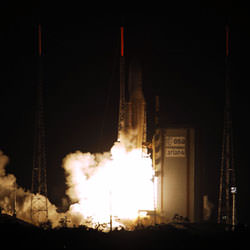
Ariane 5 rocket with two satellites on board. Image credit: ESA. Click to enlarge.
Just after midnight an Ariane 5GS successfully lifted off from Europe?s Spaceport in French Guiana. The two solid boosters ignited 7 seconds after the start-up of the cryogenic main stage, providing the power needed to lift the heavy launcher off the pad.
On board was a Syracuse 3A, built by Alcatel Alenia Space for the French Ministry of Defence and a Galaxy 15 communications satellite built by Orbital Sciences Corporation, USA, for the American company PanAmSat. Galaxy 15 is the 20th satellite to be launched by Ariane launchers for this satellite communications operator.
On arriving at orbital injection, around 26 minutes after launch, the Ariane 5 was at an altitude of about 1560 km and travelling at approximately 8633 metres a second. Syracuse 3A was the first satellite to be released, followed approximately 10 minutes later by the Galaxy 15. Both satellites have been placed in the targeted geostationary transfer orbit with very high precision.
Flight 168 is the 23rd Ariane 5 launch.
Original Source: ESA News Release
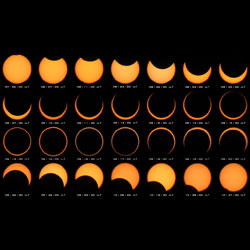
Annular eclipse. Image credit: Martin Whipp. Click to enlarge.